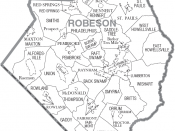THE FIGHT FOR RECOGNITION
It is hard to believe now that the plain and forthright flatlands of Robeson County could have hidden an entire people for generations. Most every part of North Carolina used to be tobacco country. But many, perhaps most, of the tobacco fields are abandoned now. The generation that has gone off to work the assembly lines in the Converse plant down at Lumberton, at Kelly-Springfield in Fayetteville, or at Campbell Soup over in Maxton hardly even remembers the grueling work of plucking tobacco and twisting it up to dry in the gap-sided sheds that still stud the fields. The speckled brick houses and the tidy mauve and aquamarine trailer homes, the new Chevy pickups, all speak of modest success and steady jobs, of people suspicious of ornament, who take pride in their surroundings. Nothing here hints of secrets. But then the hiding of the Lumbees was not entirely (perhaps not even primarily) a physical thing as much as it was a concealment of blood, a deliberate and nuanced blending into the moral and cultural order of the place.
The Lumbees have done well. There is little of the gritty, shaming poverty that scars the human landscape of Indian communities in much of the United States. Lumbees run most everything in Pembroke: the Hardee's, the Piggly Wiggly, the Rite Aid, the filling station, and the store that sells Christian music tapes and license plates that say such things as 'Expect A Miracle!' They have been landowners since property records were first written up in the 18th century. They may be correct when they boast that they have produced more doctors, lawyers, and Ph.D.'s than any other Indian group in the United States. Many Lumbees hold elected office, and a Lumbee currently represents Robeson County in the...



Good Stuff
This paper helped alot. I didnt know where to go for the information so I took the references and did my own. Thanks
7 out of 7 people found this comment useful.